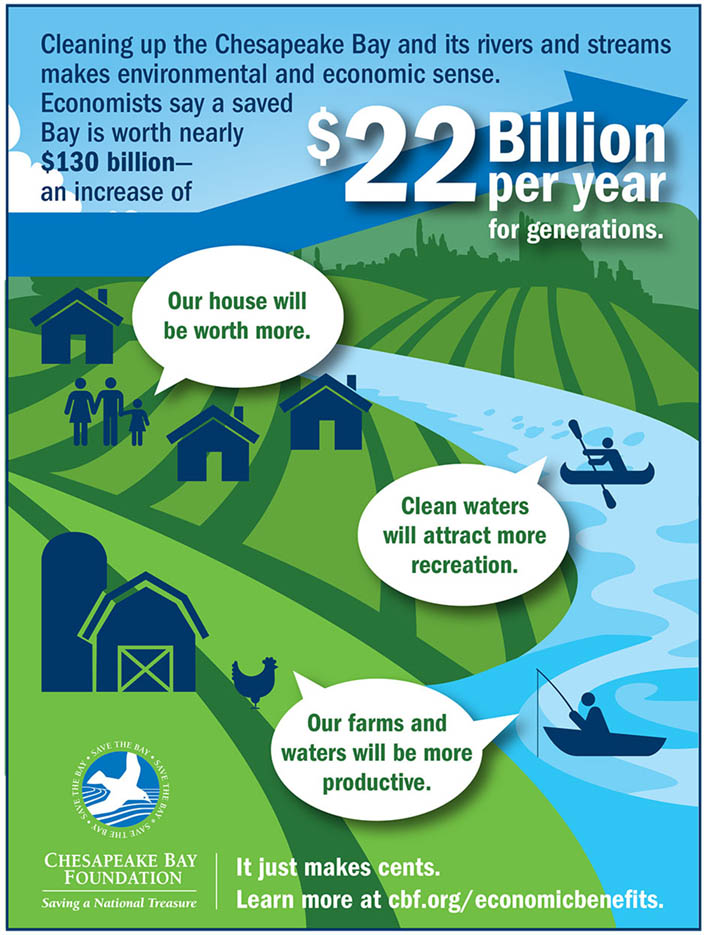The October 2014 peer-reviewed economic report, produced by economist Spencer Phillips and CBF Senior Scientist Dr. Beth McGee, compares the value of those benefits in 2009, the year before the Chesapeake Clean Water Blueprint began being implemented, to the benefits that can be expected as a result of fully implementing the Blueprint.
November 2, 2022—Fully funding the farm pollution-reduction practices needed to restore the Chesapeake Bay would inject $655 million annually into the region’s economy, including $269 million per year in higher earnings for businesses and workers, according to a report released by CBF. Agricultural Conservation Practices: Clean Water and Climate Smart Investments examined 17 conservation practices states are implementing to achieve the Chesapeake Clean Water Blueprint’s pollution cuts.
Read the press release | Read the report
The Value of The Chesapeake Clean Water Blueprint

The Natural Benefits of The Chesapeake
In 2009 (before the Blueprint) the lands and waters of the Chesapeake Bay Region provided economic benefits totaling $107.2 billion annually.
These benefits include air and water filtering, agricultural and seafood production, enhancement of property values, and protection from floods and hurricanes.
Fully implementing the Blueprint is a big job. It requires the commitment, time, and resources of many sectors of our society and to some extent, every individual in the watershed.
So what's the return?
According to this peer-reviewed economic report, The Economic Benefits of the Chesapeake Clean Water Blueprint, it will be tremendous.
The value of these same benefits will increase by $22.5 billion for a total of $129.7 billion annually if the Blueprint is implemented. Once fully realized, those benefits would accrue year after year.
If the Blueprint is not fully implemented pollution loads will increase and the value of the natural benefits will decline by $5.6 billion, bringing the total down to $101.5 billion annually.
The Value of Natural Benefits
Our lands, waters, and associated plants and animals provide natural benefits that economists call ecosysem services. People depend on them to sustain and enhance life.
These benefits include life-supporting processes such as water and air purification, flood protection, and food production. They include life-enhancing assets such as beautiful places to recreate and live.
The Link Between Natural Benefits and Land Use
Climate Stability
Influence of land cover and biologically mediated processes on maintaining a favorable climate, promoting human health, crop productivity, recreation, and other services.
Chesapeake land uses that provide this benefit: Forest, Urban Open, Wetland
Food Production
The harvest of agricultural produce, including crops, livestock, and livestock by-products; the food value of hunting, fishing, etc.; and the value of wild-caught and aquaculture-produced fin fish and shellfish.
Chesapeake land uses that provide this benefit: Agriculture, Open Water, Wetland
Water Flow Regulation
Modulation by land cover of the timing of runoff and river discharge, resulting in less severe drought, flooding, and other consequences of too much or too little water available at the wrong time or place.
Chesapeake land uses that provide this benefit: Forest, Urban Open, Urban Other, Wetland
Aesthetic Value
The role that beautiful, healthy natural areas play in attracting people to live, work, and recreate in a region; often reflected in property values.
Chesapeake land uses that provide this benefit: Agriculture, Forest, Open Water, Urban Open, Wetland, Other
Air Pollution Treatment
Purification of air through the absorption and filtering of airborne pollutants by trees and other vegetation, yielding cleaner, more breathable air (reduction of NOx, SOx, CO2), reduced illness, and an improved quality of life. (Note: Economists more commonly call this "Gas Regulation.")
Chesapeake land uses that provide this benefit: Forest, Urban Open, Wetland
Waste Treatment
Removal or breakdown of nutrient pollution and other chemicals by vegetation, microbes, and other organisms, resulting in fewer, less toxic, and/or lower volumes of pollutants in the system.
Chesapeake land uses that provide this benefit: Forest, Open Water, Wetland
Recreation
The availability of a variety of safe and pleasant landscapes—such as clean water and healthy shorelines—that encourage ecotourism, outdoor sports, fishing, wildlife watching, etc.
Chesapeake land uses that provide this benefit: Agriculture, Forest, Open Water, Urban Open, Wetland, Other
Water Supply
Filtering, retention, storage, and delivery of fresh water—both quality and quantity—for drinking, irrigation, industrial processes, and other uses.
Chesapeake land uses that provide this benefit: Forest, Open Water, Wetland
What Does That Mean for the States?
With implementation of the Blueprint, each of the states in the watershed will see substantially enhanced benefits.
Fact Sheets
- Virginia: $8.3+ billion annually
- Pennsylvania: $6.2+ billion annually
- Maryland: $4.5+ billion annually
- Delaware: $206+ million annually
- New York: $1.9+ billion annually
- West Virginia: $1.3+ billion annually
The Value of Our Ecosystems
In all cases, forests generated the largest values, because more than half (55 percent) of the watershed is forested and because the services they provide—filtering drinking water, reducing flooding, providing recreation and beauty—are highly valued.
Conclusions
The conclusions are clear.
- The Chesapeake region currently provides natural benefits of at least $107.2 billion annually. Tweet
- Post-Blueprint benefits are nearly $130 billion annually, an increase of more than $22 billion per year. Tweet
- Without the Blueprint, benefits decline to $101.5 billion annually, a loss of $5.6 billion from the 2009 baseline. Tweet
- Benefits are enjoyed throughout the entire Chesapeake Bay watershed. Tweet
Full implementation of the Blueprint makes good economic and environmental sense!



